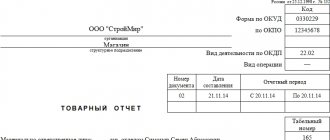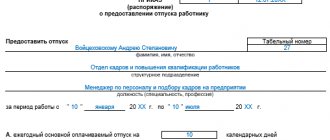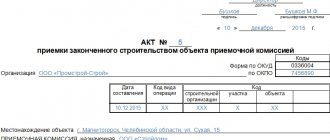Receipt of goods and materials into the organization based on quantitative and valuation is reflected in the goods acceptance certificate. It has the form TORG-1. Filling out the paperwork, as well as receiving the goods, is handled by a commission appointed by the management of the recipient company. The act of acceptance of goods is the primary accounting document. Its design must be taken with full responsibility.
- Form and sample
- Free download
- Online viewing
- Expert tested
FILES
Filling out the TORG-1 form
The obligation to fill out the unified TORG-1 form occurs upon the actual receipt of inventory items. The responsible person checks the completeness, quality and quantity with the information specified in the form. If inconsistencies and disagreements arose during acceptance, then such facts are reflected in the TORG-2 and TORG-3 acts. The act of acceptance of goods is controlled by a commission appointed by the head of the enterprise.
The TORG-1 form has a title header, a tabular part and a final section, which reflects the comments of the responsible persons and their signatures.
The title part of the document reflects the following information:
- Full name of the company;
- Details of the document on the basis of which the goods acceptance certificate is drawn up;
- The structural unit where goods are received;
- Information about primary accompanying documents (waybill, invoice);
- Information about the shipper (this information is especially important if the manufacturer and supplier are not the same person);
- Method of delivery of goods. This line indicates what type of transport the goods were delivered (by train, refrigerator, ship). If violations were committed during the transportation of valuables, then such goods may not be accepted according to the act.
- For food products subject to veterinary inspection, the date and number of the certificate received are entered.
- If the goods were insured, then the information of the insurance company is reflected in the form;
- Temperature conditions for products to be refrigerated;
- Date of arrival of inventory items.
The second section of the form lists the entire range of goods received, its quantity, weight and cost indicated in the supplier’s accompanying documents. Certification information is also provided for the product. The third section reflects actual data on the availability, quantity and weight of goods. The VAT tax rate and its amount are reflected in a separate column.
If various inconsistencies were discovered during the acceptance process, they are also recorded in the tabular section in the “Deviations” section. Moreover, negative values are reflected with a minus sign. The fourth page of the TORG-1 form contains the conclusion of the selection committee and the signatures of the responsible persons.
If a discrepancy is identified, an explanatory note is made in the form, on the basis of which the head of the company makes his decision on taking the necessary measures. A careful assessment of the received goods, as well as the entry of identified deviations, will become documentary evidence in the event of a dispute with the supplier.
Where can I find the delivery certificate for the goods?
In some particularly difficult cases, when one invoice from the supplier (TORG-12) is not enough or the goods supplied are of particular value, an act for delivery of the goods is drawn up. In this document, the parties not only confirm the fact of delivery, but also certify with their signatures the proper quality of the goods supplied.
The significance of the act is confirmed by the fact that it is signed by top officials or executives specially authorized for this procedure.
For a certificate of delivery of goods, a sample can be downloaded on our website.
How to correctly fill out a goods acceptance certificate
In order to avoid disputes with counterparties and tax authorities, the act of acceptance of goods must be drawn up in accordance with the law. For example, this is especially important when confirming the validity of the deduction of input VAT.
An incorrectly completed TORG-1 form may serve as a reason for refusing to reduce the budget payment.
In order to correctly draw up a document, you must follow the following rules:
- All columns related to a specific item must be filled out.
- The document must be signed by authorized persons.
- If the supplier is a person exempt from the accrual and payment of VAT, then this fact must be noted in the contract.
- When drawing up the act, it is necessary to check the availability of a veterinary certificate, invoice, and delivery note.
If an incorrect completion of the act was discovered, it must be redone. Particular attention should be paid to signing the document. Quite often, a facsimile signature is used in accounting documents, which is not always approved by the tax authorities. In accordance with Art. 160 of the Civil Code of the Russian Federation, such endorsement of documents is quite acceptable, but in order to avoid a conflict situation with regulatory authorities, such documents are not recommended to be taken into account.
How to register and how long to store
It is logical to assume that this document needs to be drawn up in two copies. This is necessary so that both parties have a copy on hand. Each of them is signed by the persons making the transaction. You can fill out the form on the computer or by hand. It is also necessary to remember that the executed act is transferred to the accounting department. Responsible employees of the supplier write off the goods from the organization’s balance sheet. And the accounting staff of the receiving party registers the goods.
You need to know that this act acts as a primary document. Therefore, the law determines the duration of its storage for five years after the year for which the report was made. It is important to remember that the act cannot replace the contract, but is drawn up only as an annex to it.
Rules for drawing up an act of acceptance and transfer of goods
Before filling out the document, the consent of all parties to the transaction is required.
Representatives are usually the heads of organizations. However, such a duty may also be assigned to other authorized employees who represent the interests of the company by proxy. Even if a free form of registration is chosen, the standards for drawing up similar documentation must be observed. Mandatory information displayed in the act includes information about the parties and their representatives. Data about the object of the transaction, existing faults. If there are complaints about the quality of the product, they are also indicated in the document. Signatures indicate that the parties agree with the above. If there are attachments to the act, or any additional information, this should be written down in the document. You can specify the terms of delivery of the goods and the period during which payment will be made. The need to prepare secondary acts, etc. is indicated.
If goods are transferred within the company, for example, between departments, their full name and the employee who is financially responsible are indicated. In this case, one copy is sent to the organization’s accounting department, and the second is transferred directly to the person who will monitor the safety of the goods.
Often, various valuables are transferred to a warehouse for temporary storage. In such situations, the act should also be drawn up. Often the unified MX-1 form is used here. Of course, it is not necessary to use it, but this form is quite convenient for specifying all the necessary data.
Is it possible to change the unified form of the act?
Until recently, it was possible to accept goods only using the unified TORG-1 form. With the entry into force of Federal Law No. 401-FZ, the rules for preparing primary documents have changed. Now companies have the right to independently develop convenient forms of documents that will best suit the specifics of their business. According to accounting rules, samples of such forms must be included in the accounting policy of the enterprise.
Mandatory and optional document details:
| Mandatory | Optional |
| Form name, date and document number | Shipping method |
| Name of company | Availability of a veterinary certificate |
| Product range, quantity | Information about the insurance company |
| Signatures of officials | Place of goods acceptance |
The finalized act of acceptance of goods will have legal force only if all required details are present.
Appendices to the act
Applications to the paper are filled out in a certain way. They indicate product quality requirements. So, the following can be indicated:
- Size;
- Consistency;
- Degree of freshness;
- Color and other characteristics.
Depending on what products are supplied, the quality characteristics . So, for meat it is optimal if the application indicates color, veterinary certificate, aroma, etc. For Christmas tree decorations, other characteristics are selected in the application - size, color, absence of damage, chips.
Grounds for suspending acceptance of goods
The buyer may suspend acceptance of the goods and draw up an act of suspension for the following reasons:
- When registering the goods, a discrepancy in labeling, quality and quantity was discovered;
- The integrity of the packaging is compromised and does not meet the requirements of regulatory and technical documentation;
- Violation of contractual obligations;
- Errors in accompanying documents;
- The product has expired the expiration date indicated on the packaging or is simply missing;
If violations are identified, a report is drawn up that reflects the nature of the identified defects. At the time of the proceedings, the buyer must ensure proper storage of the goods, under conditions that preclude mixing with similar homogeneous goods and materials.
Mandatory clauses of the agreement
The following information must be included:
- Name of product;
- Date of receipt of products;
- Complete data about those who carried out the transaction - their passport details, organizational details, etc.;
- Information about the agreement that served as the reason for drawing up the acceptance certificate;
- Confirmation or refutation of the quality of the product;
- The exact number of units received;
- Information about detected defects, if any;
- Duration of the contract;
- Seal or signature of authorized persons (the former may not be present).
The acceptance certificate can be drawn up both for one product and for a batch . There are no requirements for the number of goods.
Attention! There must be a section in the documentation where claims to the quality of the product will be stated. If there are none, then the counterparty signs accordingly. Leaving this form blank if there are no complaints is prohibited.
What is it?
Acceptance and transfer certificate (ATC) of goods is an A4 document, which is drawn up by the recipient and the manufacturer of material assets in order to confirm the transfer from one person to another.
The deed of transfer is not a consignment note according to the Torg-12 standard. This is an addition to the agreement previously concluded by the parties. For example, Agreement No. 4 on the supply of computers from the Eldorado household appliances store. Before signing the act, store representatives will inspect the goods and check each PC for functionality. If everything is in order, you can sign the paper and accept the products into the warehouse for further sale to consumers.
By quantity and quality
In the field of commodity circulation, acceptance of goods and materials is certified by a separate document if there is a supply agreement. The latter is regulated by the Civil Code in Art. 506-524. Thanks to it, the supplier promises to deliver the goods purchased by the buyer on a certain date. Both forms are signed bilaterally.
In general, participants in contractual relations can personally determine the contents of the accompanying documentation. And make the agreed upon adjustments. Select the “acceptance and transfer” document or the application discussed here. They must include a quantitative indicator and measure of measurement, as well as the characteristics of inventory items. You can specifically form an admissions committee to establish compliance with these parameters. This is especially important when the delivery size is large or there are multiple units included in it.
How to correctly draw up an act for the acceptance and transfer of material assets
- Document header. This indicates when and where it was compiled. The title of the document is written, reflecting its essence. You can also note which agreement this act will become an annex to.
- Information about the parties. The full names of organizations, full names and positions of employees signing the document are written here.
- Confirmation that the supplier transfers and the recipient receives the goods, fulfilling the terms of the previously drawn up contract. The terms of payment and transfer are specified.
- Below you can list all the transferred goods in separate paragraphs. However, it is more convenient to do this using a table. It includes the name, cost, quantity. General information is indicated at the bottom of the table.
- Under the table you can indicate that the product fully meets the requirements specified in the contract, so the recipient has no complaints.
- Indicate how many copies this document has. Typically, two copies are made. They have equal strength.
- The final stage is affixing signatures. As a rule, this is done by the heads of organizations. But the company can issue a power of attorney with appropriate powers to any other employee.
It should be remembered that after the document is signed by both parties, the supplier is relieved of responsibility for the safety of the goods. After this, this responsibility is assigned to the recipient party. From this moment on, the party who received the goods cannot make any claims to the supplier. After all, she has already accepted the goods by signing the act.
Although you need to understand, situations are not excluded in which the recipient will still have claims. In this case, you will have to go to court. For example, if he proves that defects in the goods were knowingly hidden from him, or he did not have the opportunity to carefully check the condition of the goods before the transaction. In such situations, only the court will be able to determine whether there are sufficient grounds to invalidate the act.
Sample of filling out the goods acceptance certificate in 2021
Comment on the rating
Thank you, your rating has been taken into account. You can also leave a comment on your rating.
Is the sample document useful?
If the document “Acceptance Certificate of Goods by Quantity and Quality” was useful to you, we ask you to leave a review about it.
Remember just 2 words:
Contract-Lawyer
And add Contract-Yurist.Ru to your bookmarks (Ctrl+D).
You will still need it!
Legal subtleties
There are a number of points that you should pay attention to before drawing up an APP for goods:
- The act is an addition to the agreement, and not an independent document (with a reference). If there is no agreement, then the act loses legal force.
- Signatures of the parties are required. Otherwise, the APP cannot be considered concluded. But the seal of organizations is not mandatory; you can do without it.
- The transfer and acceptance certificate is drawn up in 2 copies - one for each of the interested parties to the transaction.
- Various annexes (storage conditions, delivery times) can be an addition to the AMS.
- Offsets must be in rubles - but if, on the one hand, the foreign organization is not on the territory of the Russian Federation, the currency may be different. True, in this case it is better to register both national monetary units.
- The storage period for the transfer and acceptance certificate is 5 years after the year of reporting.
So, a deed of transfer is not always mandatory, but no one prohibits its execution. It allows you to record the moment of transfer of goods from the supplier (manufacturer) to the recipient (customer), and also serves as evidence in case of litigation
Is it necessary to create it?
No, but there are exceptions.
Sometimes organizations include a clause on the actual transfer of things in the basic agreement on commodity-money exchange. In such a situation, the acceptance certificate is not relevant.
But there are two exceptions:
- Transfer of complex equipment and technology, for example, medical, laboratory, computing and others. This also includes any equipment (computers).
- Sending for safekeeping - the AMS reflects the condition of the transferred goods, their appearance, as well as the storage conditions and the persons responsible for this.
An alternative to the transfer and acceptance certificate can be a delivery note. It is suitable for most cases of economic relations between individual entrepreneurs and legal entities.
Leave a comment on the document
Do you think the document is incorrect? Leave a comment and we will correct the shortcomings. Without a comment, the rating will not be taken into account!
Thank you, your rating has been taken into account. The quality of documents will increase from your activity.
| Here you can leave a comment on the document “Act of acceptance of goods by quantity and quality”, as well as ask questions associated with it. If you would like to leave a comment with a rating , then you need to rate the document at the top of the page Reply for |










